It's so good to see organizations out there giving racehorses a second chance and a new life and saving them from slaughter.
<CLICK HERE> to flip through all the pictures of OTTB's (Off the Track Thoroughbred's) waiting to be adopted and in their new jobs. ~Declan
Former racehorses get a second chance at life
updated 8:48 AM EDT, Fri May 3, 2013
STORY HIGHLIGHTS
When a racing or breeding career ends, thoroughbreds quickly lose valueOrganizations are working to provide adoption and retirement options
Thoroughbreds can be retrained as gentle therapy and family horses
(CNN) -- Wooden Phone was never asked whether he wanted to race. Born in 1997, the dull-brown thoroughbred didn't show initial signs of greatness, but the horse would net more than $800,000 in winnings during his career.
A warrior on the track, he kept coming back from severe injuries to beat likely champions. His temperament wasn't suited for the highly stressful industry -- trainers called him "difficult," a diva.
After his racing career ended at age 9, retirement didn't suit him either.
Easily agitated, Wooden Phone would pop his lip -- the equivalent of a child sucking his thumb. He was nervous just leaving the pasture.
Anyone who has been around thoroughbreds will tell you that these horses love a job, and now Wooden Phone's duties were outsourced to younger, stronger workers. Intelligent and sensitive with a drive to please, racehorses like him also crave human attention and care.
Unfortunately, when a racing or breeding career ends, thoroughbreds can quickly become useless to their owners. The injuries compound and when money and options run out, convenience leads them away from the stables and into the slaughterhouse.
"We have to improve the likelihood that a racehorse has more value alive after it is finished racing than dead," said Alex Brown, former jockey and author of "Greatness and Goodness: Barbaro and his Legacy."
The racing industry has worked to provide retirement programs and track policies that prevent slaughter. But Brown wants to see even more accountability: transparency of medical records from owner to owner, as well as support for programs that rehab ex-racehorses.
Thoroughbred Charities of America and the ASPCA's Rescuing Racers Initiative have collectively awarded millions of dollars in grants and funding to these programs.
"I think all of us who make our living with horses have an obligation to give something back and provide for the welfare of these horses," Dan Rosenberg, head of Thoroughbred Charities, said.
Suzanne Minter, an experienced rider volunteering her time at LOPE, first met Wooden Phone two years ago. His personality captured her heart.
LOPE founder Lynn Reardon was surprised by Minter's soft spot for the horse -- Wooden Phone was not an adoption candidate after his many injuries. And then, there were the stress issues.
Ex-racehorses get a bad reputation for being aggressively energetic, although their "bad manners" come from training gaps. With the right rehab techniques, they can be gentle enough to work with veterans who suffer from PTSD and children with autism.
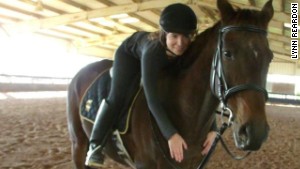
Wooden Phone and Suzanne Minter quickly bonded.
Minter was dedicated to rehabbing Wooden Phone, although it became more sporadic when she had unexpected abdominal surgery. She wasn't able to ride, but she would sit on his back as he gently stood still. As she had helped him, he took care of her in return.
"He fell in love with her. He just melted every time she came around. It was a match that was so clear the moment he met her," Reardon said. Minter adopted him.
Over a two-year period, the 16-year-old horse, once known for the foamy stress sweat on his neck, is now the gentlest horse in the barn. Together, Minter and the newly named Watson are training for dressage events.
The lip popping has evolved into quirks, such as holding one brush in his mouth while Minter uses the other to groom him, grabbing people's jackets with his teeth for fun or curiously following his new obsession: ponies.
"Ex-racehorses get overlooked sometimes because people just think they are fast, but they have a lot of heart," Minter said. "I think they are all looking for a person of their own."
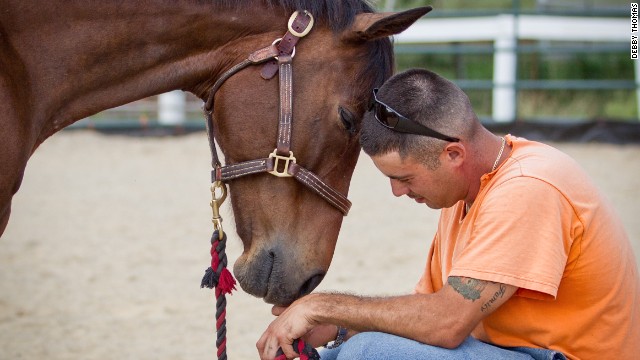 David and Ace of Hearts, which is waiting for adoption, share a moment. "Every time I go to the barn, I can tell someone has changed by being around these horses," Tucker said.
David and Ace of Hearts, which is waiting for adoption, share a moment. "Every time I go to the barn, I can tell someone has changed by being around these horses," Tucker said.
HIDE CAPTION
After the race, a new life
Turning hope into help
"There are so many places for these horses other than slaughter," Cindy Gendron of the Homes for Horses Coalition said. "Now people are using them for therapeutic riding, equine-assisted psychotherapy, show events and family horses."
The Homes for Horses Coalition aims not only to end horse slaughter, but to promote growth and collaboration in the horse rescue and protection community. Supported by the ASPCA, the Animal Welfare Institute and the Humane Society of the United States, this coalition in Washington is an umbrella for 240 organizations.
CANTER, a member of the coalition, was one of the first groups to create an online showcase of ex-racehorses in 1997. It's an all-volunteer organization with affiliates across the country, where people scour the "backsides" of racetracks every weekend and document the horses up for sale, executive director Nancy Koch said.
"The racetrack is quite a closed-in world. Not everyone can wander into the backside, you need to be escorted otherwise. We broke a lot of barriers that way," Koch said.
Other CANTER affiliates in "phase two" have taken in horses and provided rehabilitation so they can find new homes. They placed more than a thousand horses in 2012, according to the Homes for Horses Coalition.
Volunteer-based adoption farms, such as Kim Smith's Second Stride near Churchill Downs, follow a similar model and work to connect owners and horses. Like LOPE, an extensive adoption process ensures that each new home is a good fit and requires follow-ups in the months and years ahead. If the home doesn't work out, they take the horse back.
These farms also make thoroughbreds available to people who may not have five figures to spend on a horse but have the time and resources to care for one, administrative manager Leslie Pratt said.
Life after the track
"In the horse adoption world, ex-racehorses are seen as the equivalent of pit bulls," Reardon said. "People think they are edgy, so you have to do a lot of myth-busting."
Retraining can ease the issues that create negative stereotypes about ex-racers. And helping these horses can help heal the trainers, too.
The James River chapter of the Thoroughbred Retirement Foundation pairs men at a correctional facility with ex-racehorses. The horses are cared for by men who work through and graduate from a groom elite training program, which trains them for a job once they are released.
Anne Tucker, the foundation's president, likes to tell the story of Happy and Will. Happy, a nervous thoroughbred, was kicked in the face by another horse while trying to assert her authority after arriving at James River. Will was the insecure young inmate taking care of her.
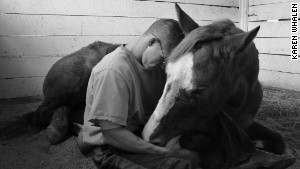
Will and Happy's bond helped them to heal each other.
"It's hard to say whether Will gave Happy confidence, or Happy gave Will confidence," Tucker said. "Horses look at everyone on even footing. The men have made some mistakes, but they aren't bad people. They just need someone to confirm that, and that's what the horses do."
The pair bonded and healed one another. Happy was adopted after a full recovery, and Will has been released and is working on a local thoroughbred breeding farm.
The golden years
"Some of these horses are like your best athletes -- they gave everything to the sport, and they got banged up in the process," said Michael Blowen, founder of Old Friends Thoroughbred Retirement Center. "To me, this is like having Larry Bird in my backyard."
Formerly with the Boston Globe, Blowen had racehorses at Suffolk Downs. He quickly learned that when the horses couldn't race anymore, they weren't "going to a riding academy in Maine" as he was told -- they were going to slaughter. He decided to dedicate the rest of his life to offering ex-racehorses a retirement paradise.
Old Friends' locations care for more than 130 horses across three states, located near racetracks so fans can come visit the "retired athletes" in big paddocks.
"It is the equine equivalent of retiring and living on a golf course, except they eat the greens," Blowen said.
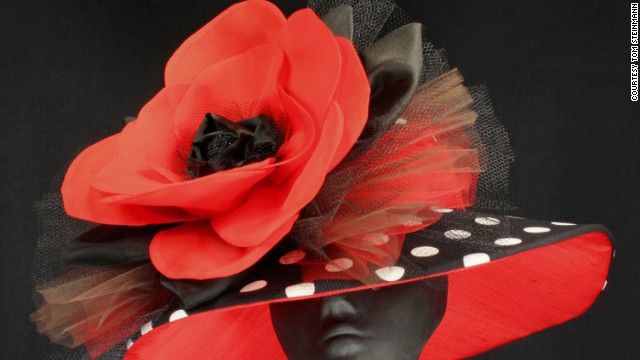
Gallery: Click the image to the left to view a collection of Kentucky Derby hats created to benefit retired racehorses.
One resident, Clever Allemont, earned $316,329 during his eight wins. In 2009, he ended up in a kill pen in Kansas, deaf with one eye set in a graying face. He seemed to know he had reached the end, according to Kristin Chambers. Chambers and Diana Baker saved himfrom a trip to the slaughterhouse.
Now, he is living out his golden years at Old Friends, gleefully rolling in the dirt and inspiring the groups of deaf children who tour the farm to see him. But not every thoroughbred that gave their lives to racing has the same happy ending.
Ferdinand, winner of the 1986 Kentucky Derby, died in a Japanese slaughterhouse in 2002, according to reporting by "The Blood-Horse" magazine. National Racing Hall of Fame's Exceller met a similar fate in 1997. After Ferdinand, Old Friends asked Japanese breeders to let them know when the horses have peaked and have since rescued Creator, Sunshine Forever, Fraise, Ogygian and Wallenda.
Old Friends has also inspired others to save ex-racehorses.
Sally Steinmann, who grew up dreaming of having her own horse, became a milliner known for her derby hats. And now some of those hats are created in honor of Old Friends and auctioned off to benefit the horses.
"I feel like these hats are little ambassadors and if anybody can learn about these horses, what we are trying to do and how much we all feel a responsibility to take care of them, then it's a really great thing," Steinmann said.
She studies photos and old racing film to craft hats that represent the horses, translating their legacies into silk dupioni with vivid trims. While the hats are extravagant pieces of wearable art, they are also creative pieces of awareness.
The art of Kentucky Derby hats
"Michael said we each get a dot, and this is his," Steinmann said. "I just want to connect our dots. We all have something we wish more than anything else that we could change in this world."
Inside and outside the racing industry, ex-racehorse welfare is a world of slowly connecting dots.
These retired horses are returning the favor by enriching the lives of the humans working to save them.
"People connect well with horses because they are gentle, instinctive creatures," Gendron said. "Just to lay your hands on a warm, powerful horse that puts his head down and looks you in the eyes is an amazing feeling, especially for someone who is in physical or emotional turmoil. Horses seem to sense that, understand it and take care of people."

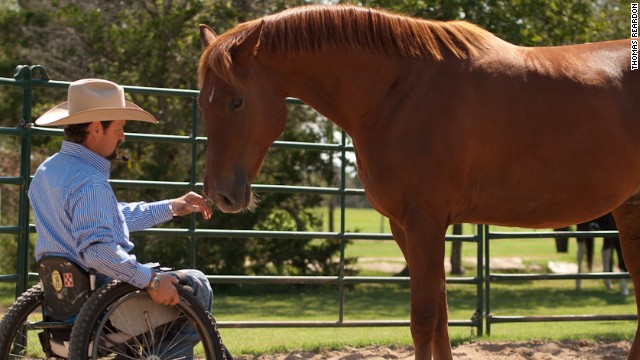 Horsemanship teacher Michael Richardson demonstrates the sensitivity and responsiveness of Santo, a former track horse at LOPE.
Horsemanship teacher Michael Richardson demonstrates the sensitivity and responsiveness of Santo, a former track horse at LOPE.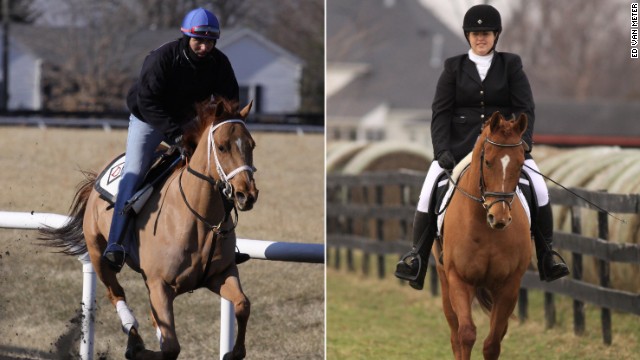 Agent Alex, adopted in 2012 by Sarah McCullough from Second Stride, before adoption, left, and after adoption. He is just starting his eventing career.
Agent Alex, adopted in 2012 by Sarah McCullough from Second Stride, before adoption, left, and after adoption. He is just starting his eventing career.
No comments:
Post a Comment